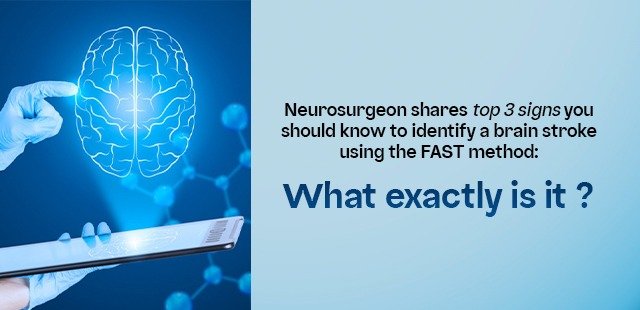Neurosurgeon shares top 3 signs you should know to identify a brain stroke using the FAST method: What exactly is it?

A brain stroke is also called a brain attack, occurs when blood flow to the brain is disturbed, either due to a clot or bleeding. Without oxygen, the brain cells begin to die rapidly, leading to speech loss, paralysis, or even death. The early signs we have to recognise to act fast, and that’s where the F.A.S.T method comes in to save lives.
In this blog, we will break down this method, share expert insights from leading neurosurgeons, and explore the latest research in brain stroke detection and treatment. Also, we will know how timely detection and care at a cancer treatment centre or the best cancer care hospitals can make all the difference.
What is a Brain Stroke
A brain stroke happens when the brain does not get proper blood and oxygen. This causes damage to the brain parts quickly.
You can consider it as a power cut in your house – but in the brain. If the power (blood supply) is blocked, brain cells begin to die soon.
How does it happen?
There are two main reasons for a brain stroke:
Blocked Blood Vessel (Ischemic Stroke): This is the most common type, when a clot blocks blood flow to the brain. Approximately 87% of strokes are ischaemic.
Burst Blood Vessel (Hemorrhagic Stroke): A blood vessel breaks and bleeds inside the brain.
What Causes Stroke?
There are some common reasons, including:
- High blood pressure
- Diabetes
- Smoking or alcohol use
- Lack of physical activity
- Stress and poor diet
- Family history of stroke or heart disease
Nowadays, it also happens suddenly, even in young people. According to WHO, it is the 2nd leading cause of death globally and in India, it affects over 1.8 million people annually.
That’s why knowing the F.A.S.T. method is so important to recognise signs fast and save lives.
Top 3 signs you should know to identify a brain stroke-
These 3 are the most important and common warning signs regarding a brain stroke. Recognising these signs can be the first step toward healing-
| Letter | Meaning | Description |
| F | Face Drooping | Spot the weakness on the face; one side may droop. |
| A | Arm Weakness | Ask one to raise their hand if they feel weakness or numbness, and may drift. |
| S | Speech Difficulty | Slurred or confused speech (Notice if any disturbance in voice) |
| T | Time to help | Time to take action. Reach the best neurosurgeon as soon as you identify these signs. |
Leading Expert Advice
Dr. Raveesh Sunkara from Hyderabad said, “Time is brain”. If you see someone with F.A.S.T. signs, then call or consult emergency services immediately.
He underlined that brain cells die rapidly during a stroke, and acting within a few hours can prevent permanent damage or death.
Apollo neurology experts‘ advice for two more signs in the original F.A.S.T method-
- Stability – Sudden loss of balance or coordination.
- Eyes – Sudden blurriness or vision loss.
They add that 1.9 million neurons die every minute if stroke goes untreated, and early intervention can reduce disability by up to 30%.
Dr. Poonam Khetrapal Singh (WHO regional director) states that each one of us can prevent stroke. Identify the early warning signs of F.A.S.T. She highlights that over 11 million strokes occur annually in low and middle-income countries, with 4 million deaths, and 30% survivors are seriously disabled.
Dr. Arun L. Naik (AIIMS, New Delhi) focuses on stroke prevention through 5 key micronutrients that many Indians lack:Magnesium, DHA (Omega-3), Creatine, Vitamin B12, Vitamin D. Micronutrient deficiencies silently chip away at the brain’s defences.
Latest Research & Development
The latest research and development regarding brain stroke that is going on worldwide and nationwide-
- The University of Maryland conducted a meta-analysis that found people with blood type A have a 16% higher risk of early stroke, while type O have a lower risk.
- The milli-spinner thrombectomy, developed by Stanford University to shrink and removes blood clots using compression and shear forces without rupturing the clot. 90% first-attempt success for tough clots. The developer has claimed that it is a sea change technology that drastically helps people.
- Nano-intervention systems are being explored in India to treat strokes more effectively in the younger population. This technology combines imaging and therapeutic agents to cross the blood-brain barrier and reduce inflammation.
Role of Best Cancer Care Hospitals
While stroke and cancer are different health conditions, multispecialty hospitals offer advanced neurology and oncology departments. These centres are equipped with- Advanced imaging and detection technology, Rehabilitation and recovery programs, 24/7 emergency-ready and relevant consultation.
So, if you see any sign of F.A.S.T within anyone – immediately reach out to the best cancer care hospital near you. Even if anyone is confused about their sign and symptoms, the hospital can provide them with proper consultation and diagnosis.